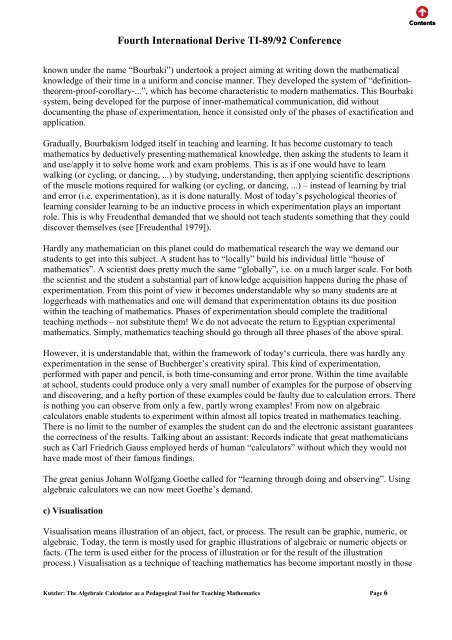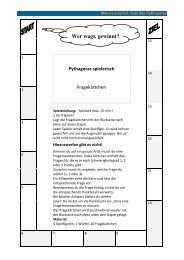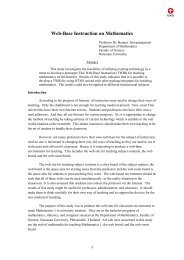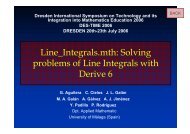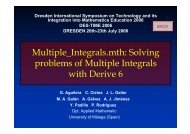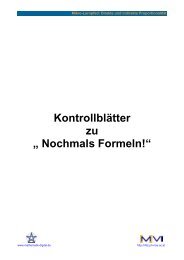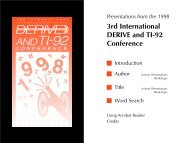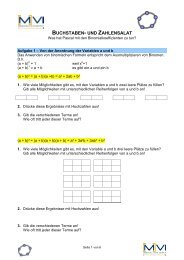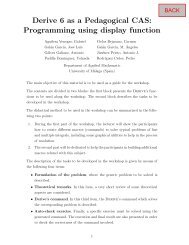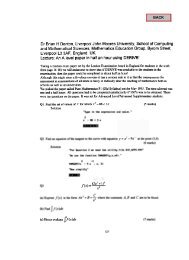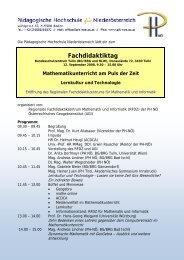The Algebraic Calculator as a Pedagogical Tool for Teaching ...
The Algebraic Calculator as a Pedagogical Tool for Teaching ...
The Algebraic Calculator as a Pedagogical Tool for Teaching ...
You also want an ePaper? Increase the reach of your titles
YUMPU automatically turns print PDFs into web optimized ePapers that Google loves.
Fourth International Derive TI-89/92 Conference<br />
known under the name “Bourbaki”) undertook a project aiming at writing down the mathematical<br />
knowledge of their time in a uni<strong>for</strong>m and concise manner. <strong>The</strong>y developed the system of “definitiontheorem-proof-corollary-...”,<br />
which h<strong>as</strong> become characteristic to modern mathematics. This Bourbaki<br />
system, being developed <strong>for</strong> the purpose of inner-mathematical communication, did without<br />
documenting the ph<strong>as</strong>e of experimentation, hence it consisted only of the ph<strong>as</strong>es of exactification and<br />
application.<br />
Gradually, Bourbakism lodged itself in teaching and learning. It h<strong>as</strong> become customary to teach<br />
mathematics by deductively presenting mathematical knowledge, then <strong>as</strong>king the students to learn it<br />
and use/apply it to solve home work and exam problems. This is <strong>as</strong> if one would have to learn<br />
walking (or cycling, or dancing, ...) by studying, understanding, then applying scientific descriptions<br />
of the muscle motions required <strong>for</strong> walking (or cycling, or dancing, ...) – instead of learning by trial<br />
and error (i.e. experimentation), <strong>as</strong> it is done naturally. Most of today’s psychological theories of<br />
learning consider learning to be an inductive process in which experimentation plays an important<br />
role. This is why Freudenthal demanded that we should not teach students something that they could<br />
discover themselves (see [Freudenthal 1979]).<br />
Hardly any mathematician on this planet could do mathematical research the way we demand our<br />
students to get into this subject. A student h<strong>as</strong> to “locally” build his individual little “house of<br />
mathematics”. A scientist does pretty much the same “globally”, i.e. on a much larger scale. For both<br />
the scientist and the student a substantial part of knowledge acquisition happens during the ph<strong>as</strong>e of<br />
experimentation. From this point of view it becomes understandable why so many students are at<br />
loggerheads with mathematics and one will demand that experimentation obtains its due position<br />
within the teaching of mathematics. Ph<strong>as</strong>es of experimentation should complete the traditional<br />
teaching methods – not substitute them! We do not advocate the return to Egyptian experimental<br />
mathematics. Simply, mathematics teaching should go through all three ph<strong>as</strong>es of the above spiral.<br />
However, it is understandable that, within the framework of today‘s curricula, there w<strong>as</strong> hardly any<br />
experimentation in the sense of Buchberger’s creativity spiral. This kind of experimentation,<br />
per<strong>for</strong>med with paper and pencil, is both time-consuming and error prone. Within the time available<br />
at school, students could produce only a very small number of examples <strong>for</strong> the purpose of observing<br />
and discovering, and a hefty portion of these examples could be faulty due to calculation errors. <strong>The</strong>re<br />
is nothing you can observe from only a few, partly wrong examples! From now on algebraic<br />
calculators enable students to experiment within almost all topics treated in mathematics teaching.<br />
<strong>The</strong>re is no limit to the number of examples the student can do and the electronic <strong>as</strong>sistant guarantees<br />
the correctness of the results. Talking about an <strong>as</strong>sistant: Records indicate that great mathematicians<br />
such <strong>as</strong> Carl Friedrich Gauss employed herds of human “calculators” without which they would not<br />
have made most of their famous findings.<br />
<strong>The</strong> great genius Johann Wolfgang Goethe called <strong>for</strong> “learning through doing and observing”. Using<br />
algebraic calculators we can now meet Goethe’s demand.<br />
c) Visualisation<br />
Visualisation means illustration of an object, fact, or process. <strong>The</strong> result can be graphic, numeric, or<br />
algebraic. Today, the term is mostly used <strong>for</strong> graphic illustrations of algebraic or numeric objects or<br />
facts. (<strong>The</strong> term is used either <strong>for</strong> the process of illustration or <strong>for</strong> the result of the illustration<br />
process.) Visualisation <strong>as</strong> a technique of teaching mathematics h<strong>as</strong> become important mostly in those<br />
Kutzler: <strong>The</strong> <strong>Algebraic</strong> <strong>Calculator</strong> <strong>as</strong> a <strong>Pedagogical</strong> <strong>Tool</strong> <strong>for</strong> <strong>Teaching</strong> Mathematics Page 6


